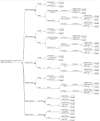A one-year economic evaluation of six alternative strategies in the management of uninvestigated upper gastrointestinal symptoms in Canadian primary care
- PMID: 20711528
- PMCID: PMC2947002
- DOI: 10.1155/2010/379583
A one-year economic evaluation of six alternative strategies in the management of uninvestigated upper gastrointestinal symptoms in Canadian primary care
Abstract
Background: The cost-effectiveness of initial strategies in managing Canadian patients with uninvestigated upper gastrointestinalsymptoms remains controversial.
Objective: To assess the cost-effectiveness of six management approaches to uninvestigated upper gastrointestinal symptoms in the Canadian setting.
Methods: The present study analyzed data from four randomized trials assessing homogeneous and complementary populations of Canadian patients with uninvestigated upper gastrointestinal symptoms with comparable outcomes. Symptom-free months, qualityadjusted life-years (QALYs) and direct costs in Canadian dollars of two management approaches based on the Canadian Dyspepsia Working Group (CanDys) Clinical Management Tool, and four additional strategies (two empirical antisecretory agents, and two prompt endoscopy) were examined and compared. Prevalence data, probabilities, utilities and costs were included in a Markov model, while sensitivity analysis used Monte Carlo simulations. Incremental cost-effectiveness ratios and cost-effectiveness acceptability curves were determined.
Results: Empirical omeprazole cost $226 per QALY ($49 per symptom-free month) per patient. CanDys omeprazole and endoscopy approaches were more effective than empirical omeprazole, but more costly. Alternatives using H2-receptor antagonists were less effective than those using a proton pump inhibitor. No significant differences were found for most incremental cost-effectiveness ratios. As willingness to pay (WTP) thresholds rose from $226 to $24,000 per QALY, empirical antisecretory approaches were less likely to be the most costeffective choice, with CanDys omeprazole progressively becoming a more likely option. For WTP values ranging from $24,000 to $70,000 per QALY, the most clinically relevant range, CanDys omeprazole was the most cost-effective strategy (32% to 46% of the time), with prompt endoscopy-proton pump inhibitor favoured at higher WTP values.
Conclusions: Although no strategy was the indisputable cost effective option, CanDys omeprazole may be the strategy of choiceover a clinically relevant range of WTP assumptions in the initial management of Canadian patients with uninvestigated dyspepsia.<p>
HISTORIQUE :: On ne s’entend toujours pas sur le rapport coût:efficacité des stratégies initiales de prise en charge des patients canadiens présentant des symptômes digestifs hauts non investigués.
OBJECTIF :: Évaluer le rapport coût:efficacité de six approches thérapeutiques aux symptômes gastro-intestinaux hauts non investigués, dans le contexte canadien.
MÉTHODE :: La présente étude a analysé les données de quatre essais randomisés visant à évaluer des populations homogènes et complémentaires de patients canadiens présentant des symptômes gastro-intestinaux hauts non investigués et des pronostics comparables. Le nombre de mois sans symptômes, les années de vie ajustées par la qualité (AVAQ) et les coûts directs en dollars canadiens de deux approches thérapeutiques établies à partir de l’outil de prise en charge clinique CanDys (pour Canadian Dyspepsia Working Group) et de quatre autres stratégies (deux agents antisécréteurs empiriques et deux endoscopies promptes) ont été analysés et comparés. Les auteurs ont inclus dans un modèle de Markov les données de prévalence, les probabilités, l’utilisation des services et les coûts, tandis que l’analyse de sensibilité a reposé sur des simulations de Monte Carlo. Les rapports coût:efficacité incrémentiels et les courbes d’acceptabilité coût:efficacité ont ainsi été déterminés.
RÉSULTATS :: L’oméprazole en traitement empirique coûte 226 $ par AVAQ (49 $ par mois sans symptômes) par patient. L’oméprazole et les approches endoscopiques selon l’indice CanDys ont été plus efficaces mais plus coûteux que l’oméprazole en traitement empirique. Les options à base d’anti-H2 ont été moins efficaces que les approches par inhibiteurs de la pompe à protons (IPP). Aucune différence significative n’a été observée pour les rapports coût:efficacité incrémentiels. À mesure que les seuils de volonté de payer (VDP) croissaient de 226 $ à 24 000 $ par AVAQ, les approches antisécrétrices empiriques étaient moins susceptibles d’être le choix le plus économique, l’oméprazole selon l’indice CanDys devenant progressivement une option plus probable. Pour les valeurs de VDP allant de 24 000 $ à 70 000 $ par AVAQ, l’éventail le plus cliniquement pertinent, l’oméprazole selon l’indice CanDys a été la stratégie la plus rentable (dans 32 % à 46 % des cas), la stratégie endoscopie prompte-IPP étant préférée avec les valeurs de VDP plus élevées.
CONCLUSIONS :: Bien qu’aucune stratégie ne se soit démarquée comme la plus rentable, l’oméprazole selon l’indice CanDys pourrait être la stratégie de choix pour un éventail cliniquement pertinent d’hypothèses de VDP dans la prise en charge initiale des patients canadiens souffrant de dyspepsie non investiguée.
Figures



References
-
- Haycox A, Einarson T, Eggleston A. The health economic impact of upper gastrointestinal symptoms in the general population: Results from the Domestic/International Gastroenterology Surveillance Study (DIGEST) Scand J Gastroenterol Suppl. 1999;231:38–47. - PubMed
-
- Penston JG, Pounder RE. A survey of dyspepsia in Great Britain. Aliment Pharmacol Ther. 1996;10:83–9. - PubMed
-
- Chiba N, Bernard L, O Brien BJ, Goeree R, Hunt RH. A Canadian physician survey of dyspepsia management. Can J Gastroenterol. 1998;12:83–90. - PubMed
-
- Rabeneck L, Menke T. Increased numbers of women, older individuals, and Blacks receive health care for dyspepsia in the United States. J Clin Gastroenterol. 2001;32:307–9. - PubMed
Publication types
MeSH terms
Substances
LinkOut - more resources
Full Text Sources
Medical
Research Materials
